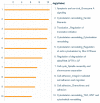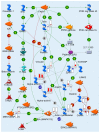Resveratrol suppresses human colon cancer cell proliferation and induces apoptosis via targeting the pentose phosphate and the talin-FAK signaling pathways-A proteomic approach
- PMID: 21849056
- PMCID: PMC3175442
- DOI: 10.1186/1477-5956-9-49
Resveratrol suppresses human colon cancer cell proliferation and induces apoptosis via targeting the pentose phosphate and the talin-FAK signaling pathways-A proteomic approach
Abstract
Background: We and others have previously reported that resveratrol (RSV) suppresses colon cancer cell proliferation and elevates apoptosis in vitro and/or in vivo, however molecular mechanisms are not fully elucidated. Particularly, little information is available on RSV's effects on metabolic pathways and the cell-extra cellular matrix (ECM) communication that are critical for cancer cell growth. To identify important targets of RSV, we analyzed whole protein fractions from HT-29 advanced human colon cancer cell line treated with solvent control, IGF-1 (10 nM) and RSV (150 μM) using LC/MS/MS-Mud PIT (Multidimensional Protein Identification Technology).
Results: Pentose phosphate pathway (PPP), a vital metabolic pathway for cell cycle progression, was elevated and suppressed by IGF-1 and RSV, respectively in the HT-29 cell line. Enzymatic assays confirmed RSV suppression of glucose-6 phosphate dehydrogenase (rate limiting) and transketolase, key enzymes of the PPP. RSV (150 μM) suppressed, whereas IGF-1 (10 nM) elevated focal adhesion complex (FAC) proteins, talin and pFAK, critical for the cell-ECM communication. Western blotting analyses confirmed the suppression or elevation of these proteins in HT-29 cancer cells treated with RSV or IGF-1, respectively.
Conclusions: Proteomic analysis enabled us to establish PPP and the talin-pFAK as targets of RSV which suppress cancer cell proliferation and induce apoptosis in the colon cancer cell line HT-29. RSV (150 μM) suppressed these pathways in the presence and absence of IGF-1, suggesting its role as a chemo-preventive agent even in obese condition.
Figures





References
-
- Stewart JR, Artime MC, O'Brian CA. Resveratrol: a candidate nutritional substance for prostate cancer prevention. J Nutr. 2003;133(7 Suppl):2440S–2443S. - PubMed
LinkOut - more resources
Full Text Sources
Other Literature Sources
Miscellaneous

